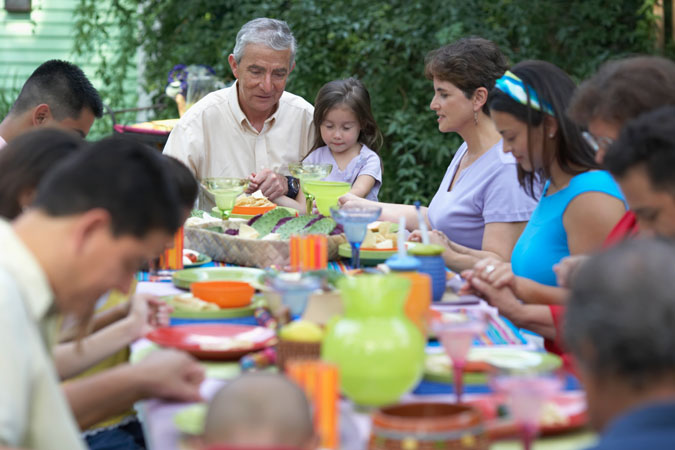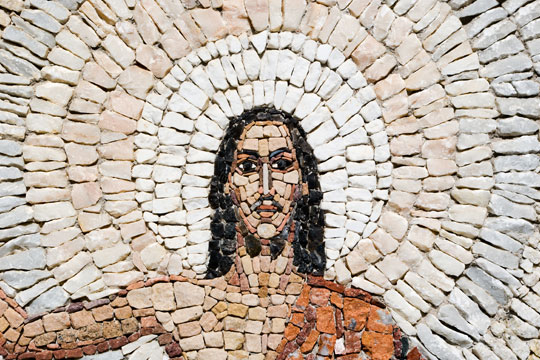
In the middle of a session, the conversation turned to the Prayer Before Meals, and I asked my seventh-graders if they knew that prayer. One girl volunteered that she knew it in Spanish, so I invited her to recite it for our group. But aside from that girl, no one indicated they knew the prayer. I directed the young people to look at the words of the prayer in the book.
The same girl who knew the Spanish version of the prayer then mentioned that her grandmother prayed the prayer anytime she ate—even before a granola-bar snack. The girl clearly thought it was unusual to pray before a snack, and her classmates nodded in agreement. I responded that it was great she prayed even before snacks and said that I tried to remember to thank God for the gift of food anytime I ate too. Not for the first time did the young people’s surprise open an opportunity for further conversation, this time about real-life prayer.
We talked about thanking God for all our gifts and how making that a habit can help us to appreciate those gifts. It was a brief conversation in the middle of a session on another topic, but taking advantage of the surprise led to a memorable moment that allowed me to share a prayer I long ago memorized (the Prayer Before Meals) and invite the young people to take the prayer to heart too.
While I have long believed in the importance of exposing the young people to a variety of prayer forms, some traditional Catholic prayers can fall through the cracks because they don’t neatly fit in the curriculum. I recognize that it is not up to me to teach all prayers in the one year I have the young people in my pre-Confirmation group, but the experience with the Prayer Before Meals reminded me that sometimes we can find opportunities to explore the words of traditional Catholic prayers.
For instance, this year I’ve noticed that the young people aren’t comfortable praying the Hail Mary even though we pray it—along with the Lord’s Prayer and the Glory Be—at the start of each session. In an upcoming session, I plan to delve into the meaning of the Hail Mary with the young people. We’ve already made the connections between the words of the prayer and the Gospel stories which give us the words, as that fit nicely into our Advent conversations. Now it’s time to look at the words more closely to help the kids understand what they pray.
How do you introduce traditional Catholic prayers to young people beyond asking for memorization? Have you had a surprise moment in a session that led to fruitful conversation about prayer or another topic?





I teach second graders and I make sure we start and end our classes with the Our Father, the Hail Mary and the Glory Be to the Father. These are three prayers that I feel they should know well before they begin third grade and preparing for their First Communion. I also try to have them memorize “Angel of God”, because it’s a short, sweet prayer I learned as a child and STILL recite as an adult.
Veronica, I suspect that it makes an impression on the children when you share that you still pray that prayer as an adult! Thanks for sharing your approach.
I struggle with my 5th graders knowing their prayers, too. This year was really tricky, because I have both ends of the spectrum and none in the middle. The kids that go to church every weekend and pray at home and those that I never see in church and didn’t remember any prayers from earlier faith formation. My goal every year is to help them to learn to pray, even if we don’t get anything else accomplished. We go over where the prayers come from (hello, Bible search). One thing I have had luck with other years is to have them rewrite the prayers in their language. As a group, we rewrite the Our Father and they seem to like that. We pray each version during each class. This year’s group, doesn’t like it. Another thing that I tried this year was to write the prayers word by word on note cards (each card has one word). Then, the last 10 minutes of class, we divide into the number of teams I have sets of cards for. We spend a couple of minutes trying to answer questions from that lesson and whichever group gets the most questions right, gets to spend that amount of time rearranging the other cards on the floor to make it harder. Then, it is a race to put the prayer in order. You have to say the Hail Mary or the Our Father a LOT of times, in order to put it in order. They like the competition and I think they are finally learning them. Plus, since their is no prize except weekly bragging rights, they help the other teams finish theirs, too.
Traci, you have some great ideas here. The fact that you channel their competitive spirit to learn prayers is a great way to engage the fifth graders.